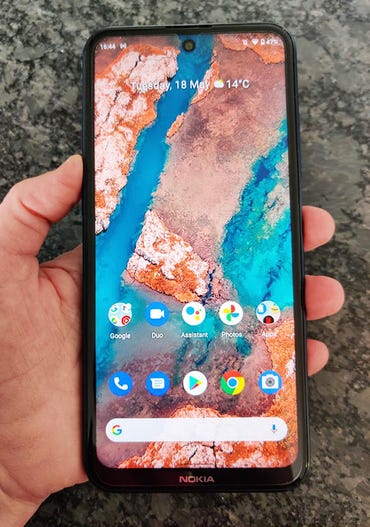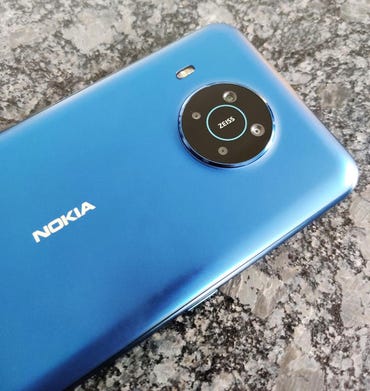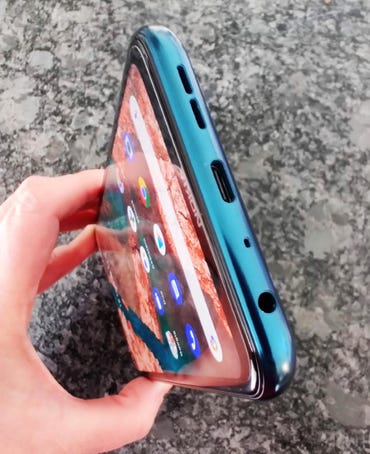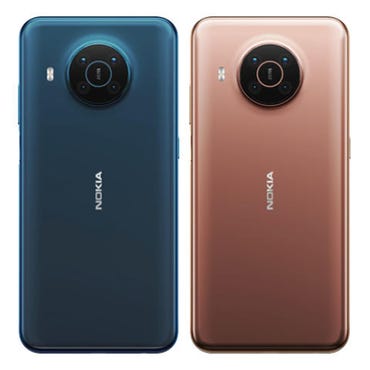Nokia recently launched a range of new handsets, including the mid-range 5G-capable Nokia X20. This 6.67-inch handset, which costs from £319.99 (with 8GB of RAM and 128GB of storage), heads up Nokia’s recent announcements, and sits in a very crowded segment of the market. Competition includes capable phones like the £349 Samsung Galaxy A52 5G, the £329 OnePlus Nord N10 5G and the £270 Realme 7 Pro and the £299 Motorola Moto G 5G Plus. All are worthy opponents, and there are plenty of others in the same price bracket.

Nokia X20: A 220g handset with a 6.67-inch IPS screen, powered by Qualcomm’s Snapdragon 480 5G chipset with 8GB of RAM and 128GB of internal storage.
Image: Sandra Vogel / ZDNetWhen Nokia launched the X20, parent company HMD Global also announced it was becoming an MVNO (Mobile Virtual Network Operator). The HMD Mobile service will offer 5G at some point, but for now anyone buying the X20 through Nokia will get a 90-day bundle of 15GB a month of data. But they won’t get 5G – that’s coming, but the connection is currently 4G. That’s a shame, given that the X20 is a 5G handset.

There are four rear cameras: 64MP (wide), 5MP (ultra-wide), 2MP (depth), 2MP (macro).
Image: Sandra Vogel / ZDNetBuy through Nokia and your X20 will have 8GB of RAM as well as that mobile bundle. Although you pay £20 extra over the entry-level 6GB, bundle-free handset, the price difference is negligible, and even if you don’t want the 90-day mobile network deal, the RAM boost should give a lift to performance. I was sent the higher-spec device for review.

The X20 is 9.1mm thick and has a 3.5mm headset jack on the bottom edge.
Image: Sandra Vogel / ZDNetThe phone ships without a wall charger (just a USB-C cable), which shouldn’t be a big deal to most of us as we’ll already have wall chargers and there’s no fast-charging capability that requires a specialist wall plug. There is a biodegradable bumper case in the box. These features are part of the environmental offer, now being espoused by HMD, which also includes — if you buy your handset direct — a tree-planting deal. Different phones are ‘worth’ a different number of trees: the X20 is worth 20 trees while the new G10 and G20 are both worth 10 trees. The trees are planted on your behalf if you register your handset.
The Nokia X20 is nicely designed, with a solid feel in the hand and an attractive backplate. There are two colour options. Midnight Sun is a bronze/gold finish, while my review handset was Nordic Blue, a darkish shade of blue. Both options have a matte finish to the backplate that’s less slippery than many, and the phone did quite well on my ‘sofa test’, clinging to the arm fairly well, although it did slide about when vibrating alerts were turned on.
There is a 3.5mm headset jack on the bottom edge of the phone and a fingerprint sensor is embedded in the on/off button on the right edge. I found the latter effective, although face unlock is also an option. There is a button dedicated to calling up Google Assistant on the left edge, where you’ll also find the SIM caddy. The X20 accommodates two SIMs or one SIM and a MicroSD card.
The camera array sits in a circular housing in the upper centre of the backplate. With the phone on a desk, pressing down on the screen on either side anywhere above halfway causes it to roll left or right, but the phone doesn’t budge under light-touch tapping.
While the Nokia X20 looks good and handles quite well, it’s fairly heavy at 220g. It’s quite chunky too, at 9.1mm thick. The desktop footprint of 79.7mm wide by 168.94mm deep houses a 6.67-inch IPS screen with very visible bezels all around and a small cut-out top centre for the front camera. The screen-to-body ratio is just 79.7%.
The X20’s display falls behind some of the similarly priced competition. For example, the Samsung Galaxy A52 5G (75.1mm x 159.9mm x 8.4mm, 189g) has a 6.5-inch Super AMOLED 1080 x 2400, 405ppi) screen. The Nokia X20 has a larger 6.67-inch screen with the same resolution (and, therefore, slightly lower 395ppi pixel density), but the IPS technology isn’t as bright and punchy, and the refresh rate is fixed at 60Hz while the Galaxy A52 5G’s panel can be set to 120Hz.
The X20 runs on Qualcomm’s Snapdragon 480 5G Mobile Platform with, in my review unit, 8GB of RAM. It delivered average Geekbench 5 CPU scores of 510 (single core) and 1689 (multi core), which is reasonable for a mid-range handset. There is 128GB of storage built in, with 18GB used out of the box, leaving 110GB for user storage. If this proves insufficient, you can one boost the storage capacity with a MicroSD card in one of the SIM slots.
SEE: 5G smartphones: A cheat sheet (free PDF) (TechRepublic)
Android 11 is provided without any UI overlay, which means there are no third-party apps duplicating the stock Android functions. It also means there are no fancy tweaks to settings, so if you’re looking for a straightforward out-of-box experience, you get that here. You also get three years of guaranteed security updates.
The front camera is a 32MP wide-angle unit that took reasonable, but not outstanding, selfies. There are four cameras at the back: 64MP wide angle; 5MP ultra-wide angle; 2MP depth-sensing; and 2MP macro. The macro camera requires a 4cm distance from the subject, so it’s pretty inflexible and doesn’t really do justice to what can be achieved with macro on a mobile.
The highlight feature is probably the Dual Sight mode, which lets you capture videos from two different perspectives, such as a standard distance and a close-up image, each sharing a portion of the screen which you can set between half-and-half and about two-thirds/one-third. Overall, though, the X20 has a distinctly average point-and-shoot camera setup.
Battery life, by contrast, is impressive. Under the PCMark for Android Work 2.0 battery test, the 4470mAh battery kept going for 16 hours and 40 minutes, and many users should be able to go for a day between charges. Neither fast charging nor wireless charging are supported.

Conclusions
The Nokia X20 is a reasonably well designed handset with good battery life, dual SIM support, 5G and a no-frills Android 11 installation, with three years of security updates guaranteed. For all that, it doesn’t really do enough to earn a top spot in the competitive mid-range 5G segment. The screen is an IPS panel with 60Hz refresh, the cameras are average, and there’s no fast or wireless charging. Unfortunately, the Nokia’s eco-credentials aren’t, on their own, enough to gain the X20 a recommendation.
RECENT AND RELATED CONTENT
HMD Global launches Nokia C, G, X series, plots wireless service, simplification
Samsung Galaxy A52 5G review: A serious mid-range 5G contender
What is 5G? Your guide to the current generation of wireless communications
5G smartphones have arrived. But for many, the reason to upgrade is still missing
Read more reviews























